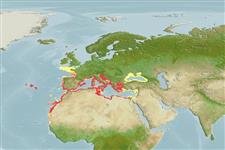Environment: milieu / climate zone / depth range / distribution range
Ökologie
seewasser demersal; tiefenbereich 5 - 150 m (Ref. 27000), usually ? - 30 m (Ref. 91154). Subtropical; 50°N - 16°N, 32°W - 42°E
Eastern Atlantic: Bay of Biscay to Mauritania (Ref. 5377), including the Canary, and Azores. Also from the Mediterranean and the Black Sea.
Length at first maturity / Size / Gewicht / Alter
Maturity: Lm 17.3, range 16 - ? cm
Max length : 36.0 cm SL Männchen/unbestimmt; (Ref. 5506); common length : 25.0 cm SL Männchen/unbestimmt; (Ref. 5506); max. veröff. Alter: 16 Jahre (Ref. 91154)
Found on rocky bottom and on Posidonia beds. Feed on fishes and crustaceans (Ref. 5506). Also found in muddy and algal or seagrass overgrown substrates. Reported to be a simultaneous hermaphrodite, which tends to spawn from early spring to early summer (Ref. 91154).
Tortonese, E., 1986. Serranidae. p. 780-792. In P.J.P. Whitehead, M.-L. Bauchot, J.-C. Hureau, J. Nielsen and E. Tortonese (eds.) Fishes of the north-eastern Atlantic and the Mediterranean. UNESCO, Paris. vol. 2. (Ref. 5506)
IUCN Rote Liste Status (Ref. 130435: Version 2024-2)
Bedrohung für Menschen
Harmless
Nutzung durch Menschen
Fischereien: weniger kommerziell; Sportfisch: ja
Tools
Zusatzinformationen
Download XML
Internet Quellen
Estimates based on models
Preferred temperature (Ref.
123201): 15.1 - 21, mean 18.4 °C (based on 72 cells).
Phylogenetic diversity index (Ref.
82804): PD
50 = 0.5000 [Uniqueness, from 0.5 = low to 2.0 = high].
Bayesian length-weight: a=0.00977 (0.00830 - 0.01151), b=3.04 (3.00 - 3.08), in cm total length, based on LWR estimates for this species (Ref.
93245).
Trophic level (Ref.
69278): 3.8 ±0.3 se; based on diet studies.
Widerstandsfähigkeit (Ref.
120179): mittel, Verdopplung der Population dauert 1,4 - 4,4 Jahre. (K=0.22-0.24).
Fishing Vulnerability (Ref.
59153): Moderate vulnerability (44 of 100).
Nutrients (Ref.
124155): Calcium = 75.5 [30.7, 150.6] mg/100g; Iron = 0.921 [0.503, 1.748] mg/100g; Protein = 18.3 [16.5, 20.0] %; Omega3 = 0.4 [0.3, 0.7] g/100g; Selenium = 26.7 [14.2, 51.5] μg/100g; VitaminA = 19.7 [6.4, 69.4] μg/100g; Zinc = 0.772 [0.552, 1.131] mg/100g (wet weight);
